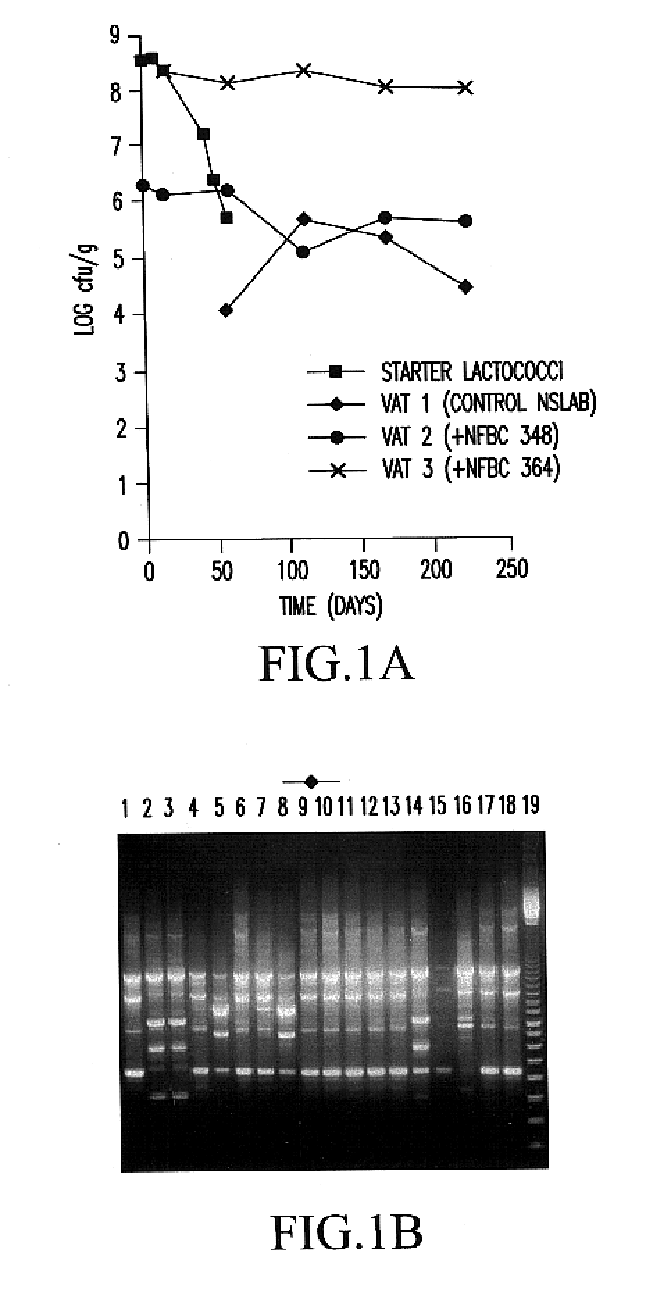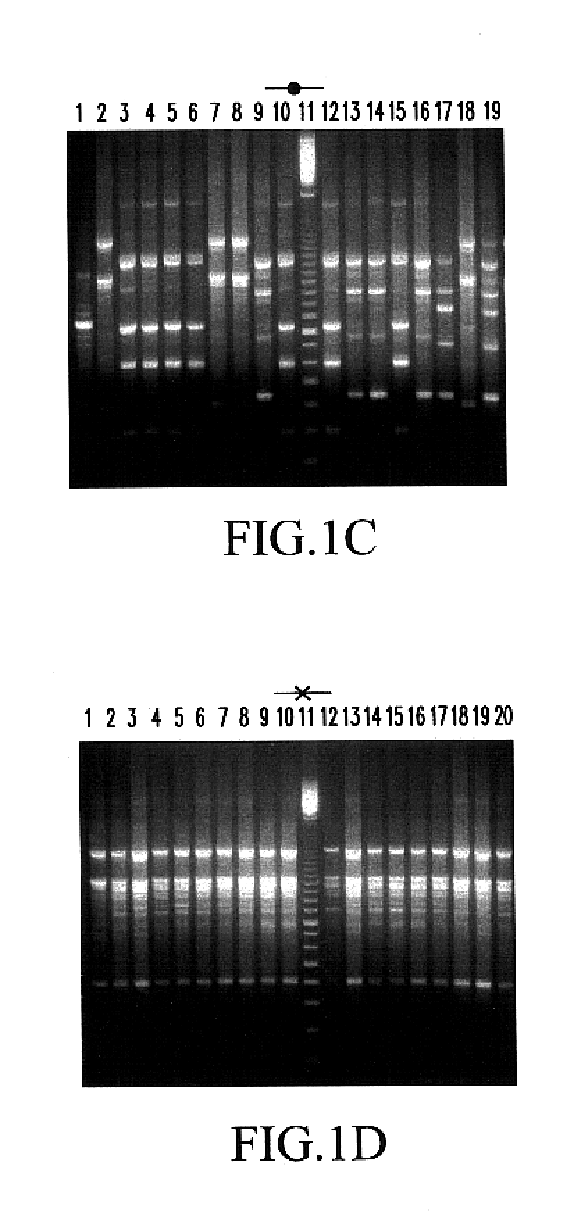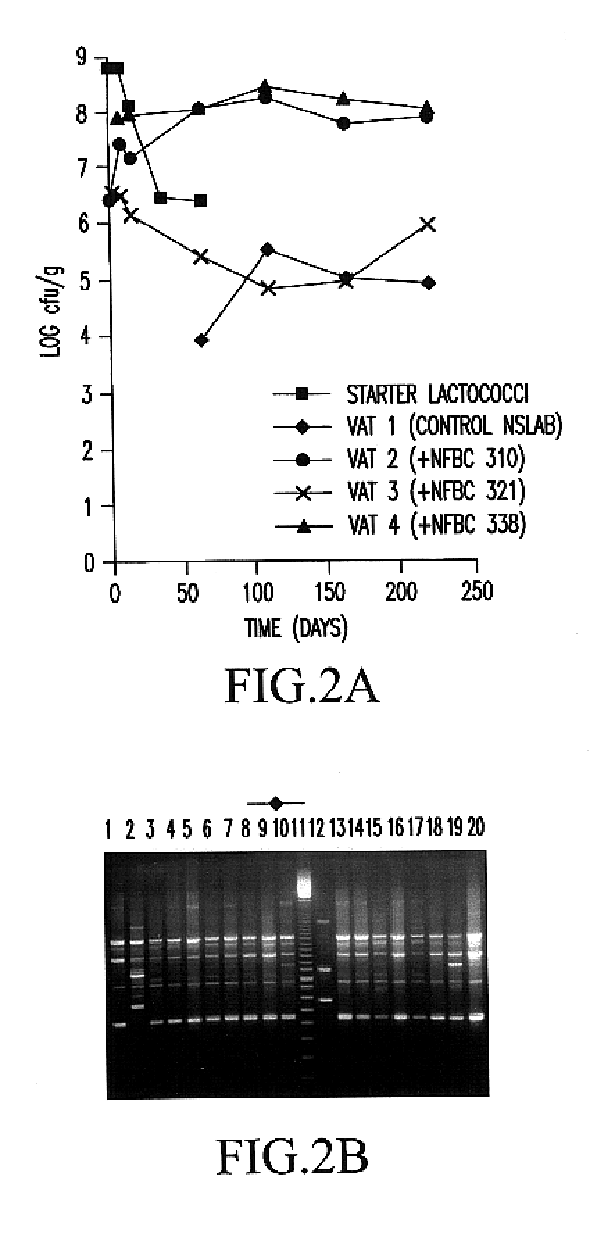Process for the manufacture of probiotic cheese
a technology of probiotic cheese and manufacturing process, which is applied in the field of manufacturing probiotic cheese, can solve the problems of not being cost-effective to add probiotic strains to cheese, and the number of starters is declining in the early weeks of ripening, so as to achieve low cost, not negatively affecting cheese quality, and high l
- Summary
- Abstract
- Description
- Claims
- Application Information
AI Technical Summary
Benefits of technology
Problems solved by technology
Method used
Image
Examples
example 1
Probiotic Strain Identification / enumeration
A pre-requisite to the successful enumeration of added probiotic strains is to be capable of selectively identifying these from the natural, often complex microflora found in food products. Since NSLAB can reach levels of up to 107-108 cfu / g in cheese during ripening it was necessary to evaluate a number of methods aimed at selectively enumerating the lactobacilli added as starter adjuncts from these NSLAB.
The probiotic Lactobacillus strains used in this Example had previously been isolated from the human gastrointestinal tract, and were obtained from Prof. J. K. Collins, Microbiology Dept., University College Cork, Ireland under the aforementioned Materials Transfer Agreement. These strains were identified as L. salivarius (ssp. salivarius) and L. paracasei (ssp. paracasei) by SDS-PAGE analysis of total cell protein. (Reuter, G. (1990) Bifidobacteria microflora 9:107-118) and were designated Lb. salivarius NFBC 310, NFBC 321 and NFBC 348 a...
example 2
Incorporation of Lactobacillus Species into Cheddar Cheese
Laboratory-scale cheesemaking trials (Trials 1 and 2) were performed initially using 25 L of pasteurised whole milk in each cheese vat. To limit contamination with wild lactobacilli, these cheeses were manufactured under controlled bacteriological conditions, as described by McSweeney, P. et al. ((1994); Irish J. Agric. Food Res. 33:183-192). A 1.5% inoculum of the mixed-strain starter culture was used and in each trial one vat (Vat 1) acted as a control to which starter only was added. To each of the experimental vats, one probiotic Lactobacillus strain, grown overnight in 10% RSM, was added as an adjunct to the starter culture. In Trial 1, the probiotic adjuncts L. salivarius NFBC 348 and L. paracasei NFBC 364 were added at an inoculum level of 0.1% to Vats 2 and 3, respectively. In the second trial, L. salivarius NFBC 310 (Vat 2), L. salivarius NFBC 321 (Vat 3) and L. paracasei NFBC 338 (Vat 4) were inoculated at a level o...
example 3
Cheese Compositional Analysis
Grated cheese samples were analysed in duplicate for salt by a potentiometric method (Irish Dairy Federation (1979); Cheese and processed cheese. Determination of chloride content: potentiometric titration method. IDF Standard 88), fat by the Gerber method (Irish Standard (1955); Determination of the percentage fat in cheese. Irish Standard. 69), moisture by oven-drying at 102° C. (Irish Dairy Federation (1982); Determination of the total solids content (cheese and processed cheese). IDF Standard 4A) and protein on a LECO FP-428 nitrogen determinator. The pH of a slurry, prepared by blending 12 ml H2O with 20 g grated cheese, was measured using a standard pH meter (Radiometer, Copenhagen, Denmark).
The composition of the cheese was generally found to be within the range typical for Cheddar as shown in Table 2.
TABLE 2Composition1 of control and probiotic Cheddar cheesesMoistureSaltS / M2FatProteinpHCheese trial(%)Trial 1V138.281.534.031.526.335.4V238.241.704...
PUM
| Property | Measurement | Unit |
|---|---|---|
| temperatures | aaaaa | aaaaa |
| temperature | aaaaa | aaaaa |
| temperatures | aaaaa | aaaaa |
Abstract
Description
Claims
Application Information
 Login to View More
Login to View More - R&D
- Intellectual Property
- Life Sciences
- Materials
- Tech Scout
- Unparalleled Data Quality
- Higher Quality Content
- 60% Fewer Hallucinations
Browse by: Latest US Patents, China's latest patents, Technical Efficacy Thesaurus, Application Domain, Technology Topic, Popular Technical Reports.
© 2025 PatSnap. All rights reserved.Legal|Privacy policy|Modern Slavery Act Transparency Statement|Sitemap|About US| Contact US: help@patsnap.com



